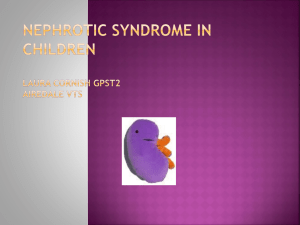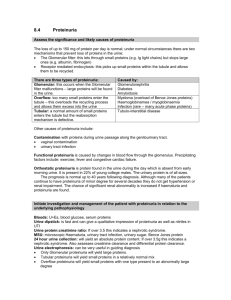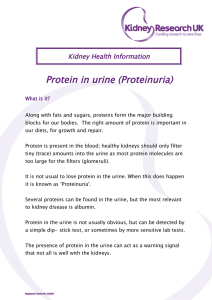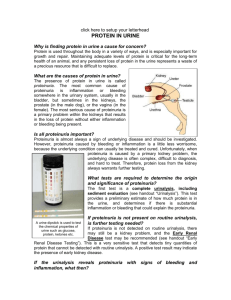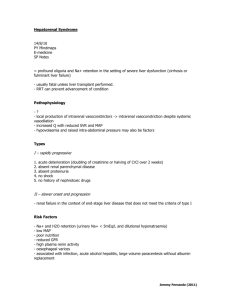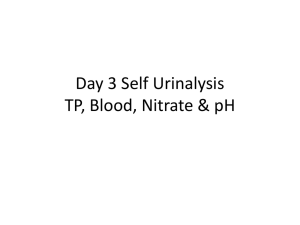Current Research Journal of Biological Sciences 4(6): 660-664, 2012 ISSN: 2041-0778
advertisement
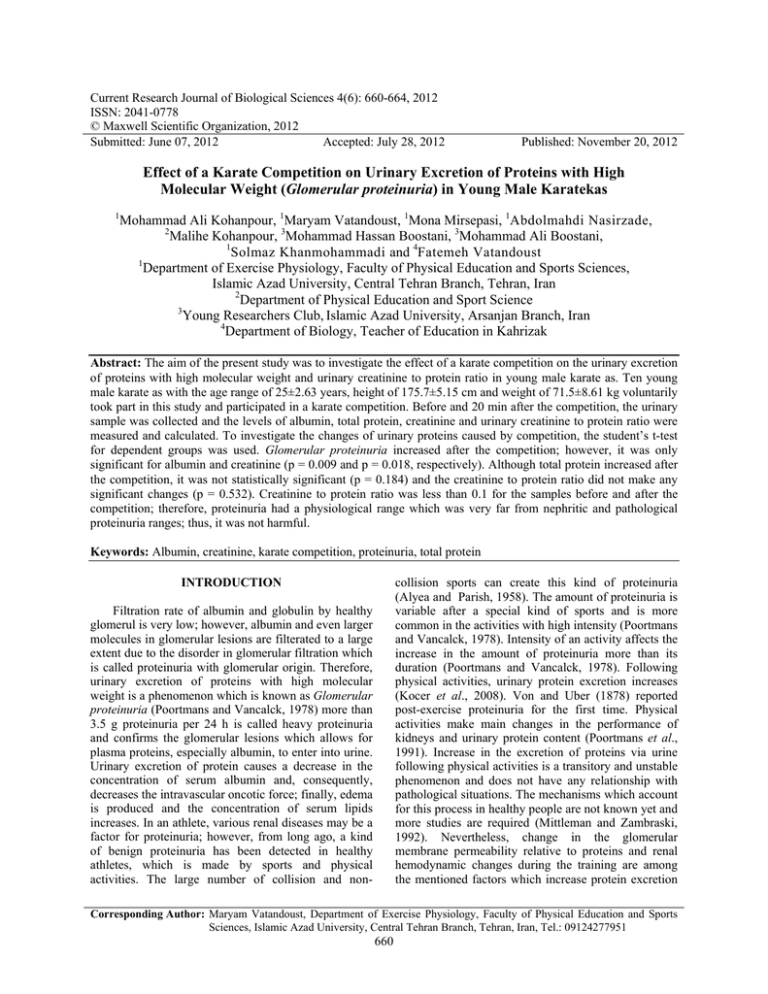
Current Research Journal of Biological Sciences 4(6): 660-664, 2012 ISSN: 2041-0778 © Maxwell Scientific Organization, 2012 Submitted: June 07, 2012 Accepted: July 28, 2012 Published: November 20, 2012 Effect of a Karate Competition on Urinary Excretion of Proteins with High Molecular Weight (Glomerular proteinuria) in Young Male Karatekas 1 Mohammad Ali Kohanpour, 1Maryam Vatandoust, 1Mona Mirsepasi, 1Abdolmahdi Nasirzade, 2 Malihe Kohanpour, 3Mohammad Hassan Boostani, 3Mohammad Ali Boostani, 1 Solmaz Khanmohammadi and 4Fatemeh Vatandoust 1 Department of Exercise Physiology, Faculty of Physical Education and Sports Sciences, Islamic Azad University, Central Tehran Branch, Tehran, Iran 2 Department of Physical Education and Sport Science 3 Young Researchers Club, Islamic Azad University, Arsanjan Branch, Iran 4 Department of Biology, Teacher of Education in Kahrizak Abstract: The aim of the present study was to investigate the effect of a karate competition on the urinary excretion of proteins with high molecular weight and urinary creatinine to protein ratio in young male karate as. Ten young male karate as with the age range of 25±2.63 years, height of 175.7±5.15 cm and weight of 71.5±8.61 kg voluntarily took part in this study and participated in a karate competition. Before and 20 min after the competition, the urinary sample was collected and the levels of albumin, total protein, creatinine and urinary creatinine to protein ratio were measured and calculated. To investigate the changes of urinary proteins caused by competition, the student’s t-test for dependent groups was used. Glomerular proteinuria increased after the competition; however, it was only significant for albumin and creatinine (p = 0.009 and p = 0.018, respectively). Although total protein increased after the competition, it was not statistically significant (p = 0.184) and the creatinine to protein ratio did not make any significant changes (p = 0.532). Creatinine to protein ratio was less than 0.1 for the samples before and after the competition; therefore, proteinuria had a physiological range which was very far from nephritic and pathological proteinuria ranges; thus, it was not harmful. Keywords: Albumin, creatinine, karate competition, proteinuria, total protein collision sports can create this kind of proteinuria (Alyea and Parish, 1958). The amount of proteinuria is variable after a special kind of sports and is more common in the activities with high intensity (Poortmans and Vancalck, 1978). Intensity of an activity affects the increase in the amount of proteinuria more than its duration (Poortmans and Vancalck, 1978). Following physical activities, urinary protein excretion increases (Kocer et al., 2008). Von and Uber (1878) reported post-exercise proteinuria for the first time. Physical activities make main changes in the performance of kidneys and urinary protein content (Poortmans et al., 1991). Increase in the excretion of proteins via urine following physical activities is a transitory and unstable phenomenon and does not have any relationship with pathological situations. The mechanisms which account for this process in healthy people are not known yet and more studies are required (Mittleman and Zambraski, 1992). Nevertheless, change in the glomerular membrane permeability relative to proteins and renal hemodynamic changes during the training are among the mentioned factors which increase protein excretion INTRODUCTION Filtration rate of albumin and globulin by healthy glomerul is very low; however, albumin and even larger molecules in glomerular lesions are filterated to a large extent due to the disorder in glomerular filtration which is called proteinuria with glomerular origin. Therefore, urinary excretion of proteins with high molecular weight is a phenomenon which is known as Glomerular proteinuria (Poortmans and Vancalck, 1978) more than 3.5 g proteinuria per 24 h is called heavy proteinuria and confirms the glomerular lesions which allows for plasma proteins, especially albumin, to enter into urine. Urinary excretion of protein causes a decrease in the concentration of serum albumin and, consequently, decreases the intravascular oncotic force; finally, edema is produced and the concentration of serum lipids increases. In an athlete, various renal diseases may be a factor for proteinuria; however, from long ago, a kind of benign proteinuria has been detected in healthy athletes, which is made by sports and physical activities. The large number of collision and non- Corresponding Author: Maryam Vatandoust, Department of Exercise Physiology, Faculty of Physical Education and Sports Sciences, Islamic Azad University, Central Tehran Branch, Tehran, Iran, Tel.: 09124277951 660 Curr. Res. J. Biol. Sci., 4(6): 660-664, 2012 (Poortmans, 1988). Both moderate and intense training in healthy people cause a kind of Glomerular proteinuria excretion, especially albumin (Boileau et al., 1980; Poortmans, 1985). Alyea and Parish (1958) reported that 70 to 80% of the athletes participating in different sports activities including contact sports like boxing and football and non-contact ones like track and field, swimming and rowing suffer from post-exercise proteinuria excretion (Alyea and Parish, 1958). Poortmans and Vancalck (1978) reported increase in the excretion of different protein types after short-term intense activities (Poortmans and Vancalck, 1978). They observed the increase in total protein and albumin after training along with the increase in their renal clearance (Poortmans and Vancalck, 1978). Carroll and Temte (2000) indicated that proteinuria excretion is a common phenomenon in adults while exercising and the benign and safe factors which create that include fever, intense physical training or sports training, dehydration, acute diseases and stress (Carroll and Temte, 2000). They stated that urinary protein excretion can be attributed to 3 glomerular, tubular and overflow categorizations, among which glomerular is the highly known one (Carroll and Temte, 2000). Considering that protein excretion in urine increases after intense activities and one of the destruction factors of kidneys is excessive protein excretion via urine, the role of physical activities in the performance of kidneys, especially protein excretion via urine, is one of the important issues in physical exercise which has attracted the attention of many specialists worldwide. The objective of the present research was to determine the levels of urinary albumin, total protein, creatinine and creatinine to protein ratio at 2 times of before and 20 min after the karate competition in young men karatekas. METHODOLOGY Participants: The participants of the study were 10 young male karatekas from Shiraz, Iran, with the age range of 25±2.63 years, height of 175.7±5.15 cm and weight of 71.5±8.61 kg. They had the experience of participating in karate tournaments at provincial level during the last 3 years. After the call for participation in the karate clubs and stating the objectives of the study, 10 qualified karate as who volunteered to participate in the study were purposefully selected after receiving the testimonial and doing medical experiments and examination. There were 5 weight groups and 2 karate as in each weight group. They were non-smokers and did not have any chronic renal, cardiovascular and other diseases in their background, have not been under any kind of operation and did not use any medications during the study. In fact, they were healthy athletes who regularly exercised for 5 days/week. Method of data collection: After choosing the participants, first, they were given complete information on the method and stages of research. Then, they filled in the written testimonial and, after performing medical examinations and experiments, their health was confirmed. They were asked to avoid the food rich in protein, fat and caffeine the night before the sampling day. Moreover, they were denied any physical activities 48 h before the sampling. In the morning of the sampling day, they emptied their bladder and came to the research venue 2 h before the sampling time. In the morning on the competition day, they drank enough water to make urine for sampling before and after the competition. Before and 20 min after the competition, the urine samples were taken from them. They were maintained in special containers at 4°C; after at most 30 min, they were given to the laboratory in both 2 sessions. In this study, albumin, total protein and urinary creatinine to protein ratio were measured and calculated. The concentrations of urine albumin, total urine protein and urine creatinine were measured by immunoturbidomentric method using the American Diasorin Kit with the sensitivity of 3 mg L, by Elisa Comasi-blue (Brad Ford) method using the American Diasorin Kit with the sensitivity of 1 mg dL and by Spectophotometry based on Jaffe Model using the American Diasorin Kit with the sensitivity of 31 mg dL, respectively. The urine creatinine to protein ratio was calculated by dividing protein by the creatinine of each sample based on the mg dL unit. Competition program: The competition program included a karate competition for 2 min with observing all the laws of this sport and under the supervision of an international referee. Thus, 2 equiponderant athletes competed with each other; since 10 participants were chosen from 5 weight groups (2 in each weight), in sum, 5 karate competitions were performed. Two researchers who were the members of Karate Team in Fars Province, Iran, completely supervised these competitions. The conducted competitions included foot and hand strikes during 2 min. Statistical methods: First, the Kolmogorov-Smirnov test was used to see whether parametric or nonparametric tests should be used and to confirm the naturalness of distribution. Thus, the student’s t-test for dependent groups was sued for investigating the changes in the studied variables. RESULTS Table 1 shows the results of descriptive statistics and Table 2 reveals the results of inferential statistics related to the changes in variables before and 20 min after the competition. After the competition, Glomerular proteinuria increased; however, this increase was only significant for albumin and creatinine (p<0.05). 661 Curr. Res. J. Biol. Sci., 4(6): 660-664, 2012 Table 1: The descriptive statistical results of variable changes from before to 20 min after the competition Variables Before competition Urine albumin (mgL) 0.83±0.55 Total urine protein (mg dL) 2.72±2.32 Urine creatinine (mg dL) 95.5±55.65 Urine creatining to protein ratio (mg dL) 0.031±0.026 Table 2: Inferential statistical results of variable changes from before to 20 min after the competition Variables t df p Urine albumin 2.88 9 0.018* Total urine protein 1.44 9 0.184 Urine creatinine 3.28 9 0.009* Urine creatining to protein ratio 0.65 9 0.532 *: The mean difference is significant at the 0.05 level Although total urine protein increased after the competition, it was not statistically significant (p>0.05). The creatinine to protein ratio non-significantly decreased in a small amount (p>0.05). DISCUSSION AND CONCLUSION The findings of the present research demonstrated that the amount of urine creatinine, total protein and albumin increased 20 min after the karate competition in young male karatekas, which was statistically significant only for albumin and creatinine. Clerico et al. (1990) observed higher urine albumin along with proteinuria caused by training (Clerico et al., 1990). De Paolo et al. (2002) showed that urine excretion of proteins increased after training (De Paolo et al., 2002). Turgut et al. (2003) stated that the concentration of urine protein increased after 2 h of volleyball training and significant increase was observed in the concentration of post-exercise urine protein and urine creatinine in both boys and girls (Turgut et al., 2003). In contrast, Fouladi (2007) reported that one session of military parade training for 4 h in two 2-h sessions with 15 min rest between the 2 sessions increased the amount of urine protein; however, this increase was not statistically significant (Fouladi, 2007). Khoshnam (1995) did not observe this significant increase (Khoshnam, 1995). In fact, it was in agreement with the non-significant increase in post-exercise total urine protein of the present research; but, as mentioned before, the significant increase of total protein has been proved after the training (Poortmans and Vancalck, 1978). The difference in these results can be attributed to the intensity of training although training duration can be also considered. Nevertheless, this kind of proteinuria is different from the natural and pathological proteinuria and includes plasma protein. The post-exercise proteinuria is not a pathological proteinuria. In mild to moderate intensity exercises, Glomerular proteinuria is more conventional (Poortmans and Vancalck, 1978). In other words, in the proteinuria after mild to moderate intensity training, the increase in the glomerular permeability is the factor and After competition 3.96±3.45 4.58±2.87 188.5±51.31 0.024±0.084 mechanism for making proteinuria (Poortmans and Vancalck, 1978). The reason for this phenomenon can be justified in different ways due to hemodynamic changes, charge disorders and hormonal effects. Some studies have supported renal artery stenos is in renal blood flow caused by adrenaline and nor adrenaline during training (Poortmans, 1984). Renal blood flow and the amount of glomerular filtration decrease by exercising. Consequently, there is a proportional increase in Filtration Fraction (FF) which leads to the facilitation in the transfer of big molecules into the tubular lumen. Also, sports increases rennin secretion and kallikrein intervention from quinine system which may increase the glomerular membrane permeability (Fouladi, 2007; Khoshnam, 1995). Along with hormonal and hemodynamic changes, loss of fixed negative charge from the capillary wall can intervene in the excretion of urine protein (Poortmans, 1985; Creeth et al., 1963). Zambraski et al. (1981) analyzed changes in renal sialic acids and pointed out that training decreases glomerular electrostatic barrier and can justify a part of increase in the macro-molecular glomerular crossing (Zambraski et al., 1981). Sentürk et al. (2007) and Kocer et al. (2008) reported an increase in the excretion of post-exercise urine proteins (Sentürk et al., 2007; Kocer et al., 2008). Although some findings have not observed statistical increase in the excretion of post-exercise urine protein (Fouladi, 2007), it seems to be related to the intensity of training. Poortmans and Vancalck (1978) demonstrated that proteinuria was almost removed 45 min after training (Poortmans and Vancalck, 1978). Previous findings have also supported that protein excretion via urine is an unstable stage with the half-time of about 1 h (Alyea and Parish, 1958; Grimby, 1965; Sentürk et al., 2007; Poortmans and Ouchinsky, 2006; Poortmans et al., 1989). Therefore, today, there is no evidence for indicating the harm of post-exercise proteinuria. Probably, Gardner (1956) was the first one who stated that sports proteinuria is different from its pathological syndrome (Gardner, 1956). Precise investigation of proteinuria is recommended in athletes. It is better to collect and investigate urine samples during 24 h after exercise. The urine creatinine to protein ratio can be used for evaluating 24 h urine protein excretion (Kristal et al., 1988). This ratio can be used for facilitating and starting medical considerations. Observations have confirmed the superiority of creatinine to protein ratio of the random urine sample for estimating the 24 h protein excretion and have found a considerable linear 662 Curr. Res. J. Biol. Sci., 4(6): 660-664, 2012 relationship between 24 h proteinuria and creatinine to protein ratio (Kristal et al., 1988). The creatinine to protein ratio of less than 0.1, between 0.1 and 1 and more than 1 can be used for detecting the range of physiological, pathological and nephritic proteinuria, respectively (Kristal et al., 1988). It has been concluded that the creatinine to protein ratio is more reliable for estimating the quantity of proteinuria and can be more widely used (Kristal et al., 1988). Moreover, it has been stated that the ratio of less than 0.2 indicates proteinuria in the normal range and that of more than 3.5 indicates the nephritic range of proteinuria (Garg et al., 2004). Therefore, the creatinine to protein ratio can be used for identifying the significance of proteinuria (Saikul et al., 2006). In the present research, a karate competition did not cause any significant changes in the creatinine to protein ratio. In fact, this ratio decreased nonsignificantly and in a low amount. Moreover, since the findings of the present study indicated the amount of less than 0.1 creatinine to protein ratio for the samples before and after the competition, therefore, 24 h postexercise urine protein excretion in the present research had a physiological range and was very far from the pathological and nephritic ranges of proteinuria. Therefore, the proteinuria after karate competition cannot be harmful. In fact, all the participants of this study had the ratio of less than 0.1 in all their samples. Sports proteinuria recurs at a certain degree of athletic sports; however, there is no proof upon which it can be stated that sports proteinuria exposes the person to chronic renal disease. Therefore, these people do not need to limit their activities. The people suffering from sports proteinuria should be under annual medical experiments and investigations and no more investigations are required by the time the amount of proteinuria is fixed and no other symptoms and signs are observed. Nevertheless, post-exercise proteinuria should be studied in other sports as well. REFERENCES Alyea, E.P., H.H. Parish and J.R. Renal, 1958. Repones to exercise: Urinary findings. J. Am. Med. Assoc., 167(7): 807-813. Boileau, M., E. Fuchs, J.M. Barry and C.V. Hodges, 1980. Stress hematuria: Athletic pseudonephritis in marathoners. Urology, 15(5): 471-474. Carroll, M.F. and J.L. Temte, 2000. Proteinuria in adults: A diagnostic approach. Am. Fam. Physician., 62: 1333-1340. Clerico, A., C. Giammattei, L. Cecchini, A. Lucchetti, L. Cruschelli, G. Penno, G. Gregori and O. Giampietro, 1990. Exercise-induced proteinuria in well-trained athletes. Clin. Chem., 36: 562-564. Creeth, J.M., R.A. Kekwick , F.V. Flynn, H. Harris and E.B. Robson, 1963. An ultracentrifuge study of urine proteins with particular reference to the proteinuria of renal tubular disorders. Clin. Chim. Acta., 8: 406-414. De Paolo, E.F., R. Gatti, F. Lancerin, E. Cappellin G. Soldà, C.B. De Palo and P. Spinella, 2002. Urinary insulin-like growth factor I in athletes before and after physical exercise and in sedentary subjects. Clin. Chim., 322(1-2): 51-57. Fouladi, O.N., 2007. Effect of one session military parade training on the amount of urine protein and blood among students of Imam Hossein (AS) University. B.Sc. Thesis, Imam Hossein (AS) University. Gardner, K.D., 1956. Athletic pseudonephritis: Alteration of urine sediment by athletic competition. J. Am. Med. Assoc., 161(17): 1613-1617. Garg, S., A.K. Gupta, A. Rohtgi and S.K. Sharma, 2004. Evaluation of random urine sample proteincretinine ratio as an index of quantitative proteinuria. J. Med. Edu. Res., 6(3): 134-137. Grimby, G., 1965. Renal clearances during prolonged supine exercise at different loads. J. Appl. Physiol., 20: 1294-1298. Khoshnam, E., 1995. Investigating and comparing the amount of urinary excretion of total protein and beta 2 microglobulin among the boxers participating in Asian boxing championship. B.Sc. Thesis, Teacher Training University, Tehran. Kocer, G., U.K. Senturk, O. Kuru and F. Gündüz, 2008. Potential sources of oxidative stress that induce post-exercise proteinuria in rats. J. Appl. Physiol., 104(4): 1063-1068. Kristal, B., S.M. Shasha, L. Labin and A. Cohen, 1988. Estimation of quantitative proteinuria by using the protein-creatinine ratio in random urine samples. Am. J. Nephrol., 8(3): 198-203. Mittleman, K.D. and E.J. Zambraski, 1992. Exerciseinduced proteinuria is attenuated by indomethacin. Med. Sci. Spor. Exercise, 24(10): 1069-1074. Poortmans, J.R., 1984. Exercise and renal function. Sport. Med., 1(2): 125-153. Poortmans, J.R., 1985. Post exercise proteinuria in humans: Facts and mechanisms. JAMA, 253(2): 236-240. Poortmans, J.R., 1988. Evidence of increased glomerular permeability to proteins during exercise in healthy man. Contrib. Nephrol., 68: 136-140. Poortmans, J.R. and B. Vancalck, 1978. Renal glomerular and impairment during strenuous exercise in women. Eur. J. Clin. Invest, 8(3): 175-178. Poortmans, J.R and M. Ouchinsky, 2006. Glomerular filtration rate and albumin excretion after maximal exercise in aging sedentary and active men. J. Biol. Sci. Med. Sci., 61(11): 1181-1185. 663 Curr. Res. J. Biol. Sci., 4(6): 660-664, 2012 Poortmans, J.R., L. Rampaer and J.C. Wolfs, 1989. Renal protein excretion after exercise in man. Eur. J. Appl. Physiol. Occup. Physiol., 58(5): 476-480. Poortmans, J.R., M.F. Engels, M. Sellier and R. Leclercq, 1991. Urine protein excretion and swimming events. Med. Sci. Sports. Exerc., 23(7): 831-835. Saikul, S., B. Wiriyasirivaj and P. Charoenchinont, 2006. First 4-hour urinary protein-creatinine ratio for diagnosis of significant proteinuria in preeclampsia. J. Med. Assoc. Thai., 89(4): 426. Sentürk, U.K., O. Kuru, G. Koçer and F. Gündüz, 2007. Biphasic pattern of exercise-induced proteinuria in sedentary and trained men. Nephron. Physiol., 105(2): 22-32. Turgut, G., B. Kaptanoglu, S. Turgut, O. Genc and S. Tekinturk, 2003. Influence of acute exercise on urinary protein, creatinine, insulin-like growth factor-i (igf-i) and igf binding protein-3 concentrations in children. Tohoku. J. Exp. Med., 201(3): 165-170. Von, L. and W. Über, 1878. Excretion of protein in the healthy human diuretic, (German). Arch. Pathol. Anat. Physiol., 72: 145-147. Zambraski, E.J., M.C. Bober, J.E. Goldstein, C.S. Lakas and M.D. Shepard, 1981. Changes in renal cortical sialic acids and colloidal iron staining associated with exercsie. Med. Sci. Spor. Exerc., 13(4): 229-232. 664
![Detection of proteinuria[1]](http://s3.studylib.net/store/data/007549979_2-02bd2c299a632d6a55125f2f2a73449c-300x300.png)
